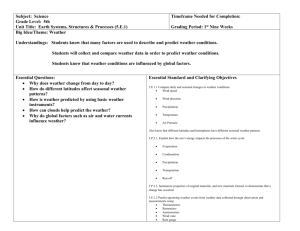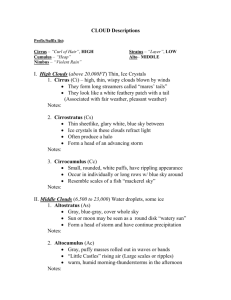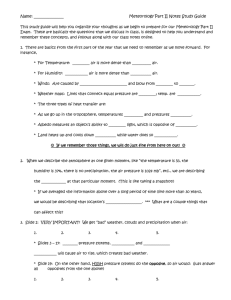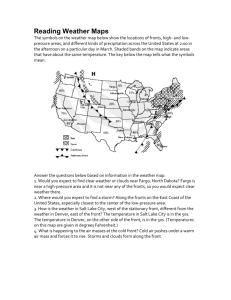VARIOUS_WX_RULES
advertisement
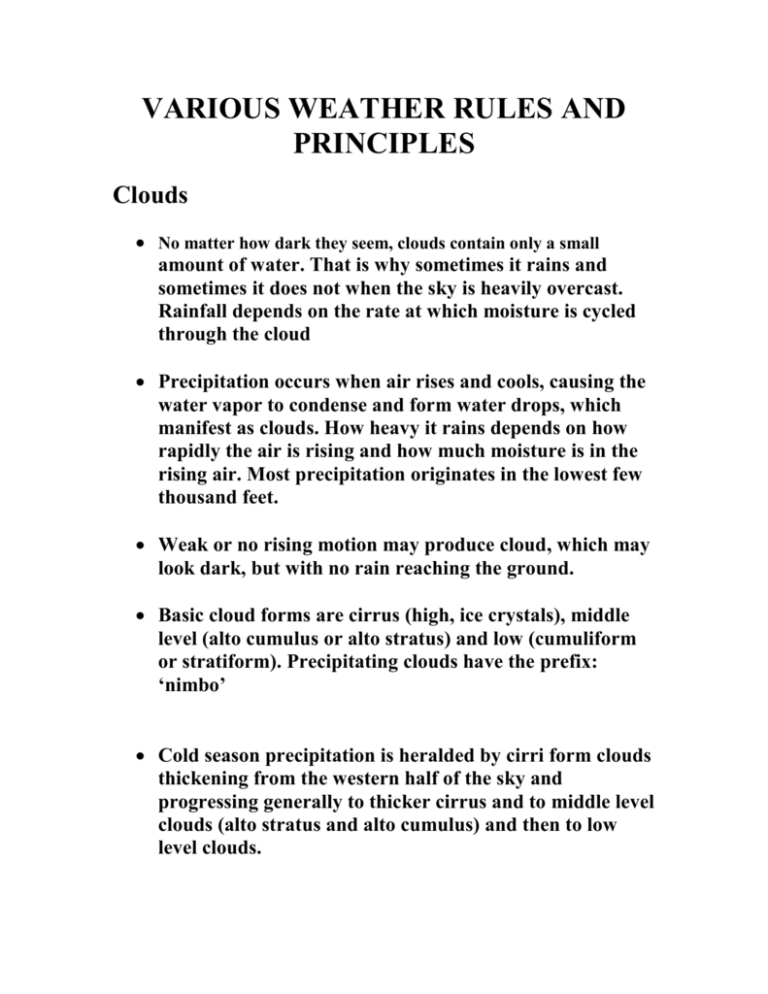
VARIOUS WEATHER RULES AND PRINCIPLES Clouds No matter how dark they seem, clouds contain only a small amount of water. That is why sometimes it rains and sometimes it does not when the sky is heavily overcast. Rainfall depends on the rate at which moisture is cycled through the cloud Precipitation occurs when air rises and cools, causing the water vapor to condense and form water drops, which manifest as clouds. How heavy it rains depends on how rapidly the air is rising and how much moisture is in the rising air. Most precipitation originates in the lowest few thousand feet. Weak or no rising motion may produce cloud, which may look dark, but with no rain reaching the ground. Basic cloud forms are cirrus (high, ice crystals), middle level (alto cumulus or alto stratus) and low (cumuliform or stratiform). Precipitating clouds have the prefix: ‘nimbo’ Cold season precipitation is heralded by cirri form clouds thickening from the western half of the sky and progressing generally to thicker cirrus and to middle level clouds (alto stratus and alto cumulus) and then to low level clouds. The faster the cloud progression the more rapidly the storm is approaching. Precipitation may take two days or more to occur during the warm season and about 12 – 24 hours during the winter. Large scale precipitation is accompanied by middle and upper cloud layers. If one can see clear, blue sky between breaks in the lower cloud, it means that the weather is improving or soon will be. An exception will be situations where the surface may force local precipitation, such as around mountains or lakes. Showers or snow squalls often follow intense cyclones that affect Pennsylvania, sometimes for up to two or three days. These showers are associated with cold northwesterly air acquiring considerable moisture upon crossing the Lake Erie. These squalls will last until the isobar over central PA becomes curved around a high pressure system, as opposed to an isobar which curves around the low. That change in curvature of the isobar signals the end of the squally period. Dry air below a low stratus deck may cause the precipitation to evaporate before it reaches the ground. This is common during winter storms in State College. Such evaporation of falling precipitation will cause the temperature near the ground to decrease, which may result in rain changing to snow or snow occurring when the temperature prior to the onset of precipitation is above freezing. Cumulus clouds can swell to become precipitating clouds. Thunderstorms will likely not occur until the cloud produces an anvil (spreading out of the cloud at high levels). Cumulus that show signs of becoming precipitating clouds or progressing to thunderstorm stage exhibit hardlooking surfaces which may resemble porcelain china on towers growing out of the tops of the clouds. Ragged cumulus will not have strong updrafts and generate precipitation The wind direction usually parallels the elongation of clouds, usually blowing along the direction of a row of clouds. Virga ( twisty horse tail-like clouds extending below the base of stratus clouds indicate that rain is falling but evaporating below cloud base. Indicates rain reaching ground soon. Barometer Rising pressure indicates large scale sinking motion, which will indicate the absence of rain Temperature inversions, which tend to confine and enhance air pollution in the lower atmosphere, occur with high barometric pressure and light wind. Falling barometric pressure indicates large scale rising motion and the likelihood of precipitation. The more rapid the barometric pressure falls, the stronger the rising motion and the sooner and the heavier the precipitation. The storm is essentially over when a falling barometer changes to a rapidly rising one. Wind Winds coming from a direction between north and west usually denote fair weather, rising barometer and clearing sky. Winds coming from a direction between south and east or northeast usually denote precipitation, falling barometer. The stormiest directions here in Pennsylvania are usually between southeast and northeast, especially when coupled with rapidly falling barometer. Nor’easters (coastal storms which sometimes cause heavy rain or snow in central Pennsylvania) typically occur with winds that shift from E or SE to NE. However, when the winds shift to the NW (especially if the pressure has begun to rise) the storm is effectively over in this area. The stronger the winds the stronger the pressure gradient and, therefore, the more rapidly changing the barometer. Nighttime cooling occurs most rapidly under clear skies, light winds and produces a temperature inversion near the ground, since the cooling occurs only in the bottom few hundred meters. Cooling is less rapid on nights with strong winds o Nocturnal cooling continues until about half hour after sunrise. o Little cooling occurs on cloudy nights Storms and Fronts Storminess tends to be confined to areas of strong temperature gradients, i.e., along fronts The upper winds tend to blow parallel to the surface isotherms (cold air on the left), but with an angle across fronts, which will be ‘steered’ by the upper winds. Face in the direction of the surface wind direction. Observe the direction of the middle or upper cloud motion. If you must rotate clockwise from the surface wind direction to the upper wind direction through an angle greater than zero or less than 180 degrees, it means that warmer air is being advected into the region, the bigger the angle up to 90 degrees, the bigger the effect. If one rotates counter clockwise through an angle greater than zero but less than 180 degrees, it means that colder air is being advected into the region, the bigger the angle up to 90 degrees the bigger the effect. Warm air advection is generally associated with rising motion. Cold air advection is generally associated with sinking motion Air moving from warmer to colder temperatures will generally be rising and therefore subject to precipitation. The stronger the temperature gradient along the direction of the wind the stronger the rising motion and the greater the effect on the surface pressure and weather. Thus, air moving pole ward and westward will generally be rising Air moving from colder to warmer temperatures will generally be sinking. Thus air moving equator ward or eastward will generally be sinking Cold fronts which approach Pennsylvania from the west, orientated north-south, or from the northwest, are accompanied by little precipitation. Frontal systems which exhibit a wave structure, consisting of a warm and cold front or as a wave along a stationary front, will have significant precipitation if the center of the low moves near or south of Pennsylvania from a direction from the west through south to southeast. Heaviest precipitation occurs in regions of strongest temperature gradient (aside from thunderstorms), i.e., on the cold side of fronts. Heaviest precipitation occurs where the air at low levels is moving across the largest temperature gradients, that is where it approaches the front at some significant angle. This is usually north of the warm front near the low center. The approach of a cirrus deck, thickening to alto stratus and alto cumulus is a harbinger of an approaching storm, if the clouds advance from a direction between SSW and NW. Outside that arc, this type of sky condition probably signifies either a coastal storm passing to the east of Pennsylvania or a weak storm moving well north of PA. In the latter case we might expect a passage of a cold front following a period of milder weather.



